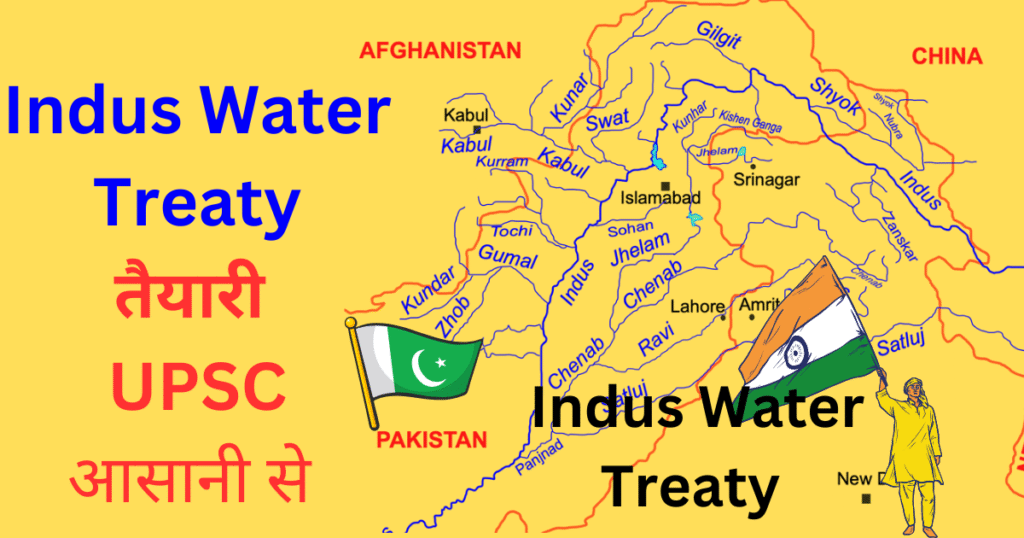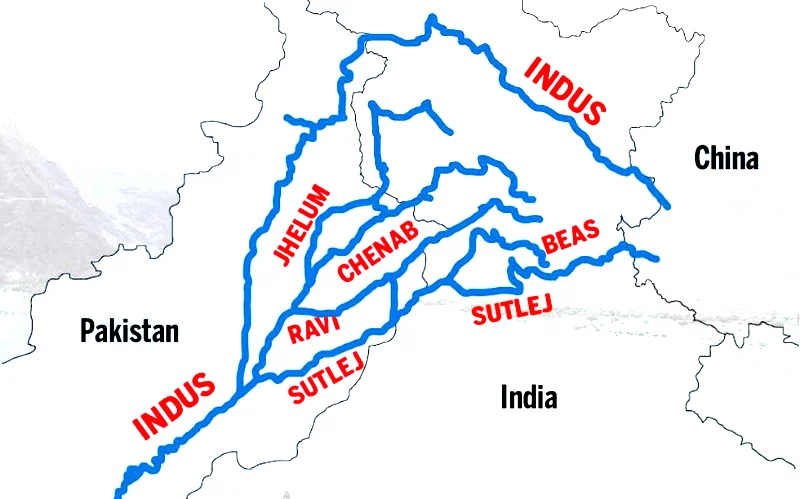Indus Water Treaty Suspension:
What is Indus Water Treaty?
The Indus River is the longest river in South Asia, spanning over 3,000 kilometers (1,864 miles) from Tibet (Under China) – J&K India – Pakistan. It includes a complex system of tributaries that flows from Tibet, through divided Kashmir, and into Pakistan, before merging into the Arabian Sea near Karachi Pakistan.

The Indus Water Treaty, a landmark agreement between India and Pakistan, was signed in 1960 in Karachi to resolve a dispute over the use of water from the Indus River system. The Indus Water Treaty was brokered by the World Bank (then the International Bank for Reconstruction and Development) and divides the Indus system’s six rivers, allocating three to each country. This ensures equitable distribution for agricultural, domestic, and industrial purposes.
Following the UN complaint, the World Bank was tasked with mediating the Indus Water Sharing dispute.

Indus Waters Treaty: Unequal Water Sharing and Geopolitical Tensions
The Indus Waters Treaty (IWT), signed on September 19, 1960, between India and Pakistan, brokered by the World Bank, is a cornerstone of water-sharing agreements in South Asia. It governs the distribution of the Indus River system’s waters, a lifeline for agriculture, hydropower, and domestic use in both nations. However, the treaty’s unequal water allocation, combined with ongoing geopolitical tensions, particularly Pakistan’s alleged support for terrorism, has sparked debates about its fairness and relevance in the modern context.
What is the Indus Waters Treaty?
The IWT divides the six major rivers of the Indus River system into two categories:
-
Eastern Rivers (allocated to India): Ravi, Beas, and Sutlej, with a combined mean annual flow of 41 billion cubic meters (30% of the total water).
-
Western Rivers (allocated to Pakistan): Indus, Jhelum, and Chenab, with a combined mean annual flow of 99 billion cubic meters (70% of the total water).
The Indus water Treaty allows India limited use of Western Rivers for non-consumptive purposes like hydropower, navigation, and fish culture, while Pakistan has exclusive rights to these waters after permitted uses in India. India, as the upstream nation, was required to supply water to Pakistan’s canals from the Eastern Rivers during a 10-year transition period, during which Pakistan developed its canal system for Western Rivers. India also contributed £62.06 million (equivalent to 125 metric tons of gold) to support Pakistan’s irrigation infrastructure.
Despite surviving three wars (1965, 1971, and Kargil), the treaty has faced strain due to disputes over India’s hydropower projects, such as the Kishanganga and Ratle dams, and Pakistan’s objections to alleged water flow reductions.
The situation escalated in April 2025, when India suspended the treaty following the Pahalgam terrorist attack, citing Pakistan’s alleged support for cross-border terrorism.
Unequal Water Sharing: A Core Indian Issue in IWT
The IWT’s water allocation heavily favors Pakistan, raising concerns about fairness given India’s larger population and land area. Here are the key facts:
-
Water Distribution: Pakistan receives 80% of the Indus basin’s water (135 million acre-feet annually), while India gets 20%. This disparity is significant, as Pakistan’s land area (796,095 km²) is roughly one-fourth of India’s (3,287,263 km²), and its population (approximately 240 million) is far smaller than India’s (1.4 billion).
-
Agricultural Dependence: Pakistan’s agriculture, which accounts for 90% of its food production, relies heavily on the Indus basin, particularly the Western Rivers. In contrast, India’s Eastern Rivers support only a fraction of its agricultural needs, with states like Punjab and Haryana facing water shortages.
-
Hydropower Potential: India’s limited access to Western Rivers restricts its hydropower development, despite growing energy demands. Projects like Kishanganga have faced objections from Pakistan, which argues they violate the treaty by reducing downstream flows.
-
Climate Change: Reduced rainfall and snowmelt have lowered water levels by 20-25% in Pakistan, exacerbating tensions. India’s upstream position gives it potential leverage, though its infrastructure limits immediate water diversion.
The unequal sharing stems from the 1960 agreement, which prioritized partitioning rivers over equitable sharing. Critics argue that India’s smaller share fails to meet its growing agricultural, industrial, and domestic demands, while Pakistan’s larger allocation supports its agrarian economy and major cities like Karachi and Lahore.
Geopolitical Tensions: Terrorism and Indus Water Treaty Suspension
Pakistan’s alleged support for terrorism has been a longstanding issue in India-Pakistan relations, further complicating the IWT. India accuses Pakistan of harboring and funding terrorists, including those responsible for attacks in Indian-administered Kashmir, such as the Pahalgam attack in April 2025, which killed 26 civilians. Posts on X highlight the sentiment that Pakistan’s actions, including alleged state-sponsored terrorism, have justified India’s decision to suspend the treaty.
Key points of contention include:
-
Terrorism Allegations: India claims Pakistan supports groups responsible for attacks like 26-11-2008 Mumbai Attack, Uri (2016), Pulwama (2019), and Pahalgam (2025). The Pahalgam attack, where attackers reportedly targeted victims based on religion, prompted India to suspend the IWT, trade, and diplomatic ties.
-
Pakistan’s Nuclear Threats: Pakistan’s frequent references to its nuclear arsenal, combined with its support for terrorism, have heightened tensions. India views these as attempts to deter actions like treaty suspension.
-
Treaty Suspension: On April 23, 2025, India announced it would hold the IWT “in abeyance” until Pakistan ends support for terrorism. This marks the first disruption of the treaty in 65 years. India has stopped sharing hydrological data, critical for Pakistan’s flood forecasting and irrigation planning.
Pakistan denies involvement in terrorism and has called the suspension an “act of war,” warning that water flow reductions could devastate its agriculture. Experts note that India’s limited storage infrastructure prevents immediate water diversion, but future projects could significantly impact Pakistan.
Implications of the Indus Water Treaty Suspension
The suspension has far-reaching consequences for both nations:
-
Pakistan’s Agriculture: The Indus basin supports 80% of Pakistan’s irrigated agriculture, including crops like wheat, rice, and sugarcane. Erratic water flows could reduce yields, raise food prices, and harm small-scale farmers.
-
India’s Strategy: India may accelerate dam and canal projects to utilize its share of Western Rivers, potentially reducing flows to Pakistan. However, challenging terrain and domestic protests have slowed such developments.
-
Regional Stability: The suspension risks escalating tensions, with Pakistan viewing water as a “lifeline.” Some Pakistani officials and farmers fear India could “weaponize” water by causing floods or droughts.
-
Climate Change: Both nations face water scarcity due to climate change, with low rainfall and glacial retreat reducing Indus flows. The treaty’s outdated framework lacks provisions to address these challenges.
Why the Indus Water Treaty Needs Reform
The IWT, while successful for decades, is increasingly outdated.
Key reasons for reform include:
-
Unequal Allocation: India’s 20% share is insufficient for its population and economic needs, while Pakistan’s 80% exceeds its proportional requirements.
-
Climate Change: The treaty lacks mechanisms to address reduced water availability, a critical issue for both nations.
-
Geopolitical Realities: Ongoing terrorism allegations and nuclear rhetoric undermine the treaty’s spirit of “goodwill and cooperation.”
-
Modern Needs: India’s growing energy and irrigation demands require greater access to Western Rivers, while Pakistan seeks assurances against upstream disruptions.
India has sought bilateral modifications since 2023, but Pakistan’s refusal has stalled progress. The World Bank, a treaty facilitator, has clarified it cannot intervene beyond mediation.
1. China
China, an upper riparian state for the Indus and Brahmaputra rivers, plays a significant role in regional hydropolitics. The Indus originates in Tibet (China), and China has developed hydropower projects, such as the planned mega-dam on the Yarlung Tsangpo (Brahmaputra) (BBC).
Impact of Indus Water Treaty Suspension: India’s suspension of the IWT could prompt China to cite this precedent to justify withholding water data or altering flows on rivers flowing into India. During the 2017 Doklam crisis, China stopped sharing hydro data with India, and similar actions could follow.
Consequences: Strained India-China relations could disrupt water cooperation, affecting India’s northeastern states and Bangladesh, which rely on the Brahmaputra. This could escalate regional tensions, particularly given China’s alliance with Pakistan through CPEC.
2. Bangladesh
Bangladesh, downstream of India on the Ganges and Brahmaputra rivers, is negotiating the renewal of the Ganga Water Treaty, set to expire in 2026. India’s suspension of the Indus Water Treaty may raise concerns about India’s commitment to water-sharing agreements.
Impact of Indus Water Treaty Suspension: Bangladesh may fear that India could adopt a similar approach to the Ganga Water Treaty, affecting its agriculture and water security. This could complicate bilateral negotiations and erode trust.
Consequences: Deteriorating India-Bangladesh relations could undermine regional cooperation on climate change and water management, critical issues given the increasing glacial melt in the Hindu Kush-Himalaya region.
3. Nepal
Nepal, another downstream neighbor, relies on rivers like the Kosi and Gandak, which originate in India or are influenced by Indian infrastructure. India’s willingness to suspend the IWT may alarm Nepal, which has historically felt pressured by India in water negotiations (Climate-Diplomacy).
Impact of Indus Water Treaty Suspension: Nepal may perceive India’s actions as a signal of potential unilateralism in other water-sharing agreements, affecting projects like the Kosi Barrage.
Consequences: Strained India-Nepal relations could hinder joint water management efforts, exacerbating flood risks and water scarcity in Nepal’s Terai region.





